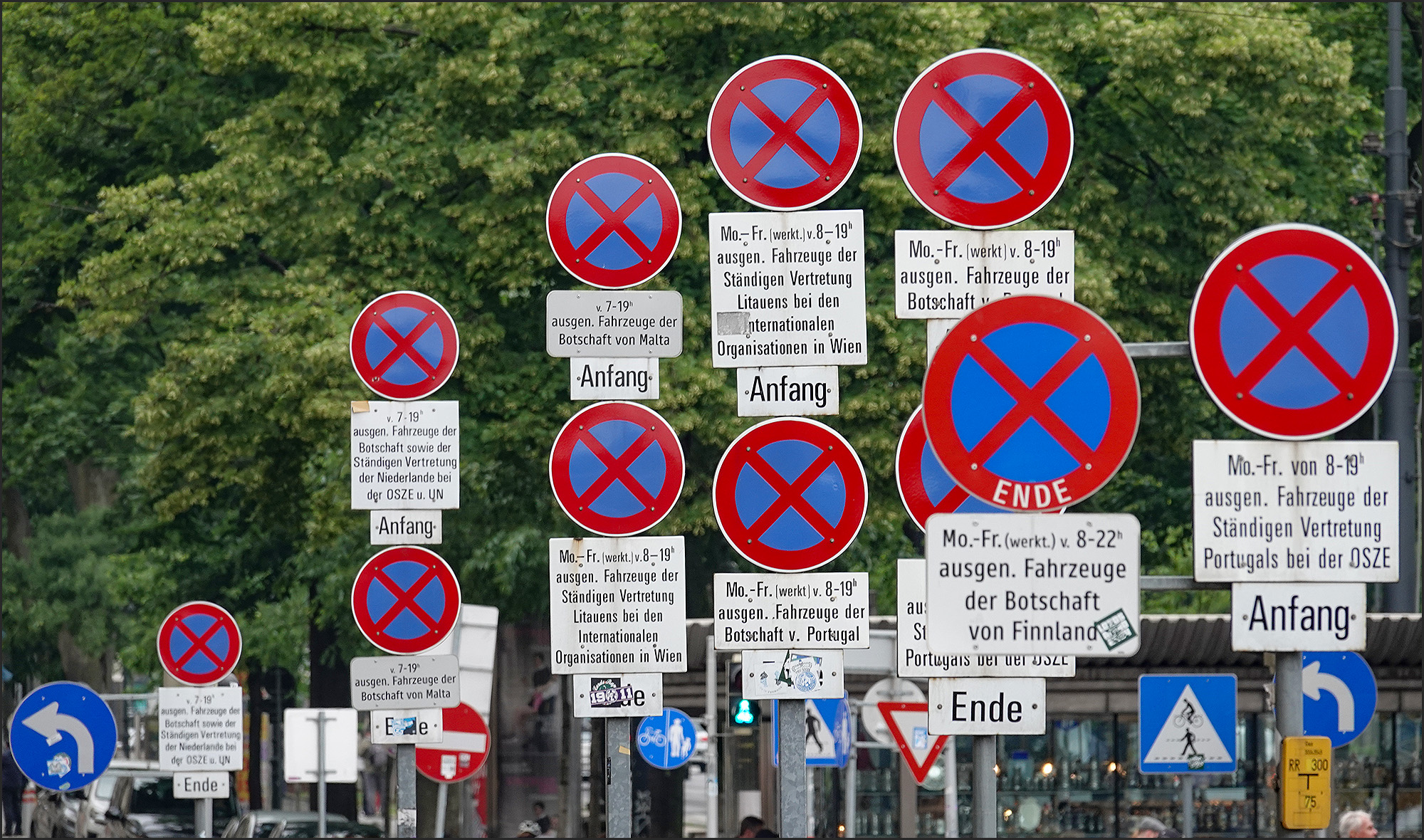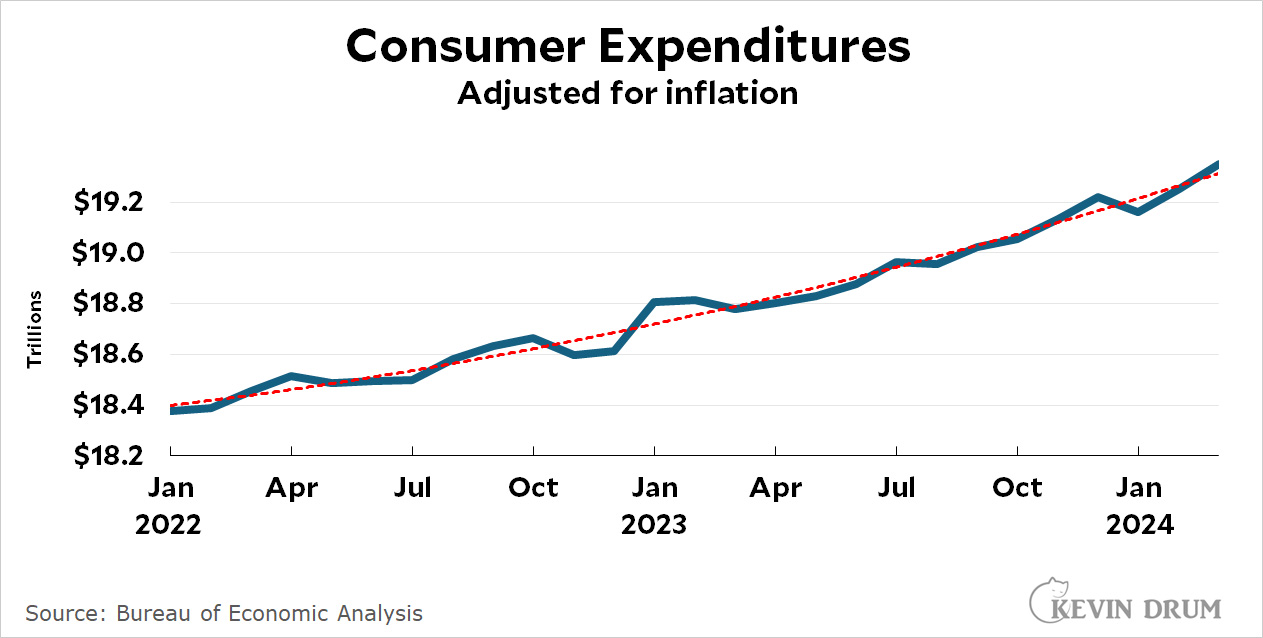I've taken many pictures of Vienna, most of which will never get their day in the sun in the coveted competition to be named Lunchtime Photo. So here's a whole bunch of them: some that just amused me, others that are interesting but not photographically exceptional.
For example, parking in Vienna can be tight:
 Sometimes this is because parking is really, really forbidden:
Sometimes this is because parking is really, really forbidden:
 The best part of this festival of no parking signs is that every one of them has a slightly different set of regulations underneath it. I have no idea how anyone can figure out what they are and aren't allowed to do here.
The best part of this festival of no parking signs is that every one of them has a slightly different set of regulations underneath it. I have no idea how anyone can figure out what they are and aren't allowed to do here.
Karlskirche has the following high above the altar:
 These are the Hebrew letters for YHWH, or Jehovah. Is this common in Christian churches? I've never noticed it before.
These are the Hebrew letters for YHWH, or Jehovah. Is this common in Christian churches? I've never noticed it before.
Here's a painting at the Belvedere Museum (left). Compare and contrast it with the Haunted Mansion stretching picture from Disneyland (right).
 One thing I noticed at the Belvedere—which is an art museum—is that a few of the descriptions included charts. My kind of art museum! But then I visited the newly opened (and free) Wien Museum and their exhibits were loaded with charts. For example:
One thing I noticed at the Belvedere—which is an art museum—is that a few of the descriptions included charts. My kind of art museum! But then I visited the newly opened (and free) Wien Museum and their exhibits were loaded with charts. For example:
 The Wien Museum had tons of stuff like. Some were better than others, though. This one breaks a whole bunch of chart laws:
The Wien Museum had tons of stuff like. Some were better than others, though. This one breaks a whole bunch of chart laws:
 On the bright side, this is a welcome change from historical claims that Jews controlled all the money. This time Protestants are the villains.
On the bright side, this is a welcome change from historical claims that Jews controlled all the money. This time Protestants are the villains.
The Wien Museum was recommended to us by our waiter at dinner one night, and it was pretty interesting. But also very eclectic and, for my taste, a little heavy handed on the wokeness. One display, for example, was titled "Architecture in the Service of Power," which perhaps was hardly necessary for an exhibit about buildings constructed during the 18th century height of empire. The best example, however, was for a reconstruction of playwright Franz Grillparzer's home:
 First off, there's the earnest question, "Is the room original though?" Answer #1: this is a purely linguistic question that depends on how you define "original." Answer #2: Who cares?
First off, there's the earnest question, "Is the room original though?" Answer #1: this is a purely linguistic question that depends on how you define "original." Answer #2: Who cares?
At the very end, though, we get the coup de grâce: Today, we're told, we view this reconstruction not merely as a glimpse into the life of a famous person, but "through a lens of Biedermeier-period social relations and gender roles." Sure we do. In any case, here's the room:
 But speaking of gender roles, another exhibit at the Wien Museum informed me that at 19th century Viennese balls the women were often given miniature reproductions to wear. Just think! You could have been the lucky gal who got to dance all night with a miniature Bessemer converter pinned to your gown:
But speaking of gender roles, another exhibit at the Wien Museum informed me that at 19th century Viennese balls the women were often given miniature reproductions to wear. Just think! You could have been the lucky gal who got to dance all night with a miniature Bessemer converter pinned to your gown:
 Here's the Prater amusement park from high in they sky. It looks a wee bit different these days than it did in The Third Man—which, by the way, shows several times a week at the Burg Kino. We caught a screening on Saturday.
Here's the Prater amusement park from high in they sky. It looks a wee bit different these days than it did in The Third Man—which, by the way, shows several times a week at the Burg Kino. We caught a screening on Saturday.
 Finally, here's a picture of the Vienna subways—in this case the U4 picking us up at Schwedenplatz, our local hub for all things transit. According to Wikipedia, "It was previously called Ferdinandplatz, but was renamed after World War I to thank Sweden for sending aid to Austria."
Finally, here's a picture of the Vienna subways—in this case the U4 picking us up at Schwedenplatz, our local hub for all things transit. According to Wikipedia, "It was previously called Ferdinandplatz, but was renamed after World War I to thank Sweden for sending aid to Austria."
















